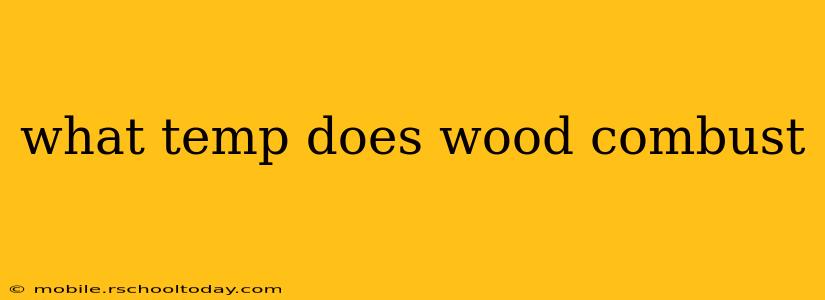What Temperature Does Wood Combust? The Science of Wood Burning
The temperature at which wood combusts isn't a single, fixed number. It's a complex process influenced by several factors, making a precise answer elusive. However, we can explore the crucial temperature ranges and the variables that affect the ignition and burning of wood.
Understanding the Combustion Process:
Wood combustion isn't a simple event; it's a series of chemical reactions. It begins with pyrolysis, a process where heat breaks down wood into volatile gases (like methane, methanol, and other hydrocarbons), water vapor, and charcoal. These gases then mix with oxygen in the air, and when the mixture reaches its ignition temperature, it ignites, producing flames. The charcoal, a carbon-rich residue, continues to burn, releasing heat and energy.
The Key Temperature Ranges:
While a precise combustion temperature for wood is difficult to state, several key temperature ranges are important:
-
Pyrolysis Temperature: This is the temperature range where wood begins to decompose. This generally starts around 200-260°C (392-500°F), although the specific temperature depends heavily on the type of wood, its moisture content, and the heating rate.
-
Ignition Temperature: This is the temperature at which the released gases ignite. This is typically between 250-300°C (482-572°F), again varying based on the factors mentioned above.
-
Sustained Combustion Temperature: Once ignited, the continued burning of wood requires a consistent temperature. This temperature is typically between 300-500°C (572-932°F), with higher temperatures achieved in a well-ventilated environment.
Factors Affecting Wood Combustion Temperature:
Several factors influence the temperature at which wood combusts:
-
Wood Species: Different wood species have varying chemical compositions, affecting their pyrolysis and ignition temperatures. Hardwoods generally have a higher density and burn hotter than softwoods.
-
Moisture Content: Wet wood requires more energy to evaporate the water before pyrolysis can begin, raising the effective ignition temperature. Dry wood ignites and burns more easily at lower temperatures.
-
Oxygen Supply: Adequate oxygen is essential for sustained combustion. A lack of oxygen will result in incomplete combustion, producing smoke and lower temperatures.
-
Particle Size: Smaller wood particles, like sawdust or wood shavings, ignite and burn more readily than larger pieces due to their increased surface area.
-
Heating Rate: A rapid heating rate can lead to a lower apparent ignition temperature, while slower heating rates may result in higher ignition temperatures.
Frequently Asked Questions (FAQs)
What is the kindling temperature of wood?
Kindling temperature refers to the temperature at which small pieces of wood begin to ignite and sustain combustion. This is generally lower than the ignition temperature of larger pieces of wood and is heavily influenced by the factors mentioned above, particularly moisture content and oxygen supply. It falls within the 250-300°C (482-572°F) range, but can vary considerably.
At what temperature does wood turn to ash?
Wood doesn't simply "turn to ash" at a specific temperature. The process of ash formation is a gradual one, occurring as the volatile components of wood are driven off during pyrolysis and combustion. High temperatures (above 500°C or 932°F) accelerate this process, leaving behind primarily inorganic minerals as ash.
Is there a difference in the combustion temperature between hardwoods and softwoods?
Yes, there is a difference. Hardwoods generally have a higher density and contain more lignin, leading to a higher heat output and potentially a slightly higher sustained combustion temperature compared to softwoods. However, the overall temperature range remains relatively similar.
How does moisture content affect the temperature at which wood burns?
Moisture content significantly impacts the combustion temperature. Wet wood requires a considerable amount of heat energy to evaporate the water before pyrolysis and combustion can begin efficiently. This effectively raises the ignition temperature. Dry wood, conversely, ignites and burns much more readily at lower temperatures.
Understanding the complex interplay of these factors provides a more complete picture of wood combustion than simply stating a single temperature. This knowledge is crucial for various applications, from safe fireplace use to efficient biomass energy production.
